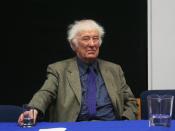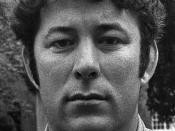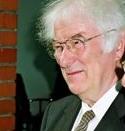There are only a few similarities between 'Afternoons', by Philip Larkin, and 'Churning Day', by Seamus Heaney. These feature mainly in the structure of the two poems. They both use enjambment for the whole length of the poem, with just one end-stopped line present in each. Enjambment gives both poems a sense of continuous movement. This is appropriate in 'Churning Day' as it represents the motion of the person churning the butter. It also makes the voice of 'Churning Day' sound out of breath, as if they are breathing in the middle of sentences, also suitable as they have just 'slugged and thumped for hours'. The sense of motion is appropriate in 'Afternoons' as the poem is about transience from childhood love and innocence to marriage and the hassles and mundane nature of everyday life.
Although there is no rhyme scheme in either poem, Philip Larkin uses many words such as 'bordering', 'lying' and 'pushing' with the same endings.
This is used as a rhyme scheme, not only to keep the poem flowing but also to add a sense of monotony that now prevails in the women's lives. As the poem flows more it makes it sound like Larkin's own thoughts as he observes these 'young mothers...setting free their children'. The lack of rhyme scheme is used to give the reader the impression of free flowing thought or speech again in 'Churning Day'. This is appropriate as it is a memory. It is clear that it is a happy memory for Heaney as he can remember so much of it, and although he remembers the 'acrid' stench of the house after churning day, he talks of the butter as 'gold flecks' and 'coagulated sunlight', which are pleasant and fond memories. It was a happy memory as the family...


